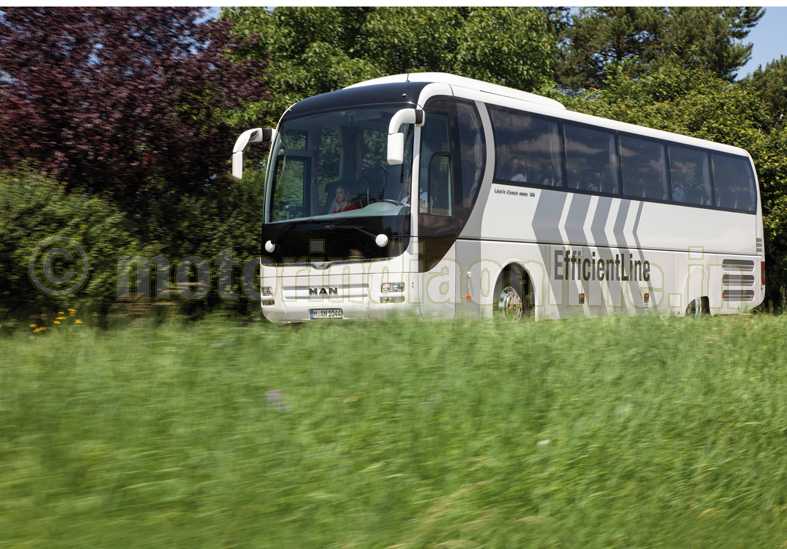 Busworld 2013 witnessed presentation by MAN and NEOPLAN of efficient, innovative transport solutions designed precisely to meet individual customer and market requirements. The commercial vehicle manufacturer exhibited its entire range of buses equipped with economical and powerful Euro 6 engines. MAN even had the exceptionally low fuel consumption of the NEOPLAN Cityliner in the Euro 6 version certified in a test run by the German Technical Board of Control (TÜV Sued). Even then, new interiors provide even more comfort, and Emergency Brake Assist (EBA) supplements the MAN driver assistant systems already available for the bus segment. Alternative drives continue to gain ground in local public transport, with natural gas in particular being an environment-friendly type of fuel in this sector.
Busworld 2013 witnessed presentation by MAN and NEOPLAN of efficient, innovative transport solutions designed precisely to meet individual customer and market requirements. The commercial vehicle manufacturer exhibited its entire range of buses equipped with economical and powerful Euro 6 engines. MAN even had the exceptionally low fuel consumption of the NEOPLAN Cityliner in the Euro 6 version certified in a test run by the German Technical Board of Control (TÜV Sued). Even then, new interiors provide even more comfort, and Emergency Brake Assist (EBA) supplements the MAN driver assistant systems already available for the bus segment. Alternative drives continue to gain ground in local public transport, with natural gas in particular being an environment-friendly type of fuel in this sector.
MAN which has over 40 years’ experience in developing and producing natural gas buses offers economical, eco-friendly and reliable bus solutions. Technological progress and innovative products have always been what distinguishes MAN. This is why MAN didn’t simply research how cities will shape future mobility, but in a study also shows unconventional concepts for the future of the bus.
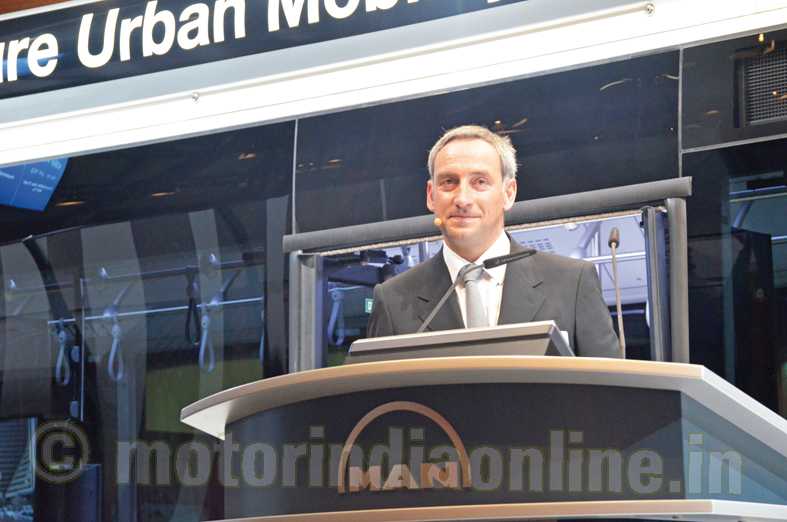 All the buses exhibited at Busworld 2013 comply with the Euro 6 emission standard, which comes into force on January 1 next. While the fuel consumption of MAN’s Euro 6 city buses is on average three to five per cent lower than that of their EEV counterparts, the Euro 6 versions of inter-city buses and coaches from MAN and NEOPLAN also remain fuel-efficient By comparison with buses equipped with EEV engines, fuel savings of up to three per cent were determined.
All the buses exhibited at Busworld 2013 comply with the Euro 6 emission standard, which comes into force on January 1 next. While the fuel consumption of MAN’s Euro 6 city buses is on average three to five per cent lower than that of their EEV counterparts, the Euro 6 versions of inter-city buses and coaches from MAN and NEOPLAN also remain fuel-efficient By comparison with buses equipped with EEV engines, fuel savings of up to three per cent were determined.
Just how miserly the MAN and NEOPLAN buses are was ascertained in a test of the NEOPLAN Cityliner Euro 6 version, certified by Germany’s leading testing institute, the Technical Board of Control. A round course of 1,320 km that can be seen as representative of a coach route was defined. Subsequent to evaluation of the data recorded during the trips, the NEOPLAN Cityliner was certified as exhibiting the extremely economical fuel consumption of around 19.8 litres per hundred km – a value without parallel amongst its competitors.
This means that the vehicle is not only extremely economical to operate but also extremely low in CO2 emissions. When fully utilized, the NEOPLAN Cityliner emits a mere 11 grams of CO2 per passenger-km. This test run demonstrates impressively that compared with aeroplanes, trains and passenger cars, the bus is the most environment-friendly means of transport.
NEOPLAN Jetliner in Euro 6
The Euro 6 version of the versatile NEOPLAN Jetliner combination bus celebrated its world premiere at Busworld 2013. The Jetliner offers the comfort of a genuine coach, with large luggage compartment volume, excellent driving properties and high-end materials options for the interior. Its floor height of 1,070 millimetres is the basis of its use as “double earner”. It allows maximum flexibility for the choice of seating, offers up to 8 m³ luggage compartment volume, and has the perfect access height for use in regular-service operation.
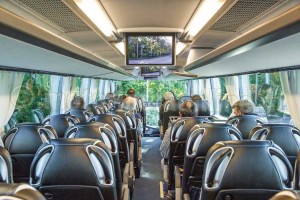 The high standards set for the vehicle’s interior design are met by a large selection of high-quality fab-rics for the seats and coverings. A comprehensive standard safety package guarantees out-standing driving safety round the clock.
The high standards set for the vehicle’s interior design are met by a large selection of high-quality fab-rics for the seats and coverings. A comprehensive standard safety package guarantees out-standing driving safety round the clock.
At Busworld, MAN presented the NEOPLAN Jetliner with a 360-hp six-cylinder D20 engine complying with Euro 6 plus 12-speed MAN TipMatic Coach automated transmis-sion. In addition, the exhibit at the fair was equipped with a wheelchair lift, which greatly sim-plifies boarding and alighting for mobility-challenged passengers.
MAN CNG buses
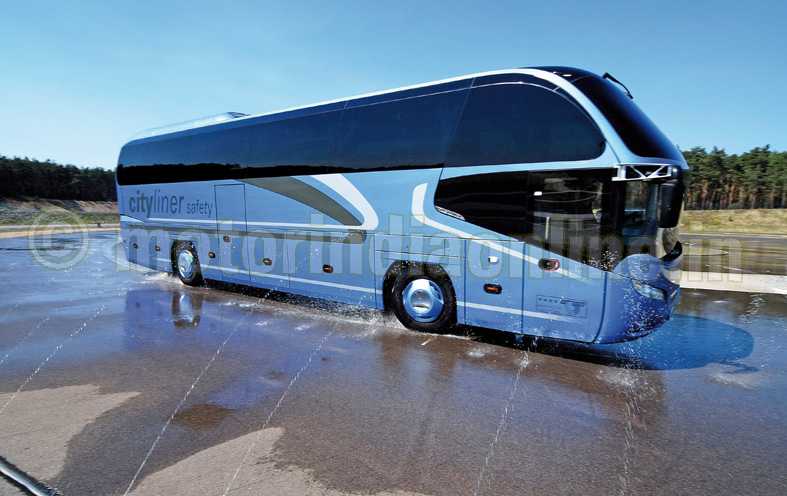 MAN has more than 40 years’ experience with natural-gas buses and has since 2000 delivered over 7,500 natural gas buses, bus chassis with natural-gas engines and individual natural gas engines. With clean, powerful engines in compliance with Euro 6 as well as a wide range of CNG complete buses, MAN offers an alternative to conventional diesel propulsion that remains significantly below the levels required by what is currently the most stringent emission standard, and that completely without filter technology or additives. Without any need for technical modifications, CNG engines and buses from MAN can also be run on treated biogas, which makes operation CO2 neutral.
MAN has more than 40 years’ experience with natural-gas buses and has since 2000 delivered over 7,500 natural gas buses, bus chassis with natural-gas engines and individual natural gas engines. With clean, powerful engines in compliance with Euro 6 as well as a wide range of CNG complete buses, MAN offers an alternative to conventional diesel propulsion that remains significantly below the levels required by what is currently the most stringent emission standard, and that completely without filter technology or additives. Without any need for technical modifications, CNG engines and buses from MAN can also be run on treated biogas, which makes operation CO2 neutral.
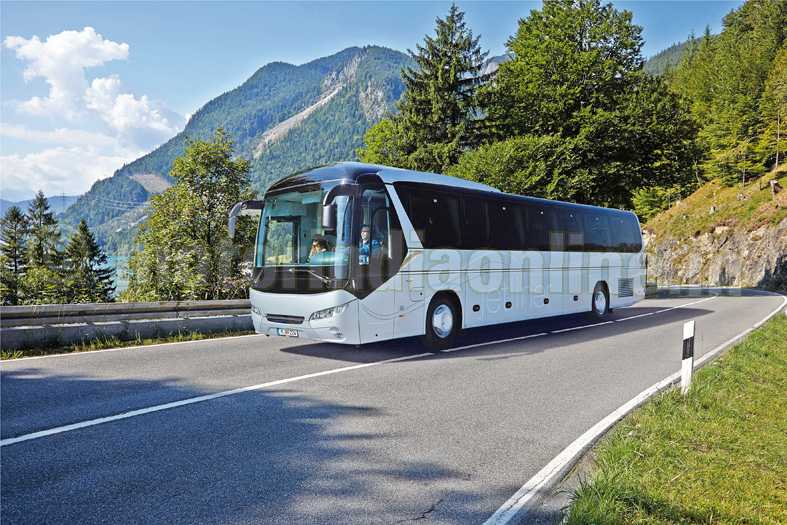
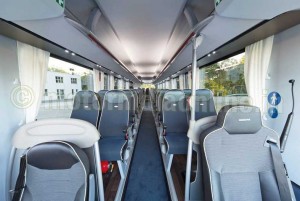 An analysis of the lifecycle costs of diesel and CNG buses shows the benefits for customers who choose natural gas as their power source. Looked at over a period of 10 years, a MAN Lion’s City CNG saves fuel costs totalling around €150,000 by comparison with a diesel bus from the same model range. Natural gas and bio-gas are eco-friendly, economical and future-proof alternatives, particularly for urban bus companies that are able to use an existing infra-structure to supply them with energy.
An analysis of the lifecycle costs of diesel and CNG buses shows the benefits for customers who choose natural gas as their power source. Looked at over a period of 10 years, a MAN Lion’s City CNG saves fuel costs totalling around €150,000 by comparison with a diesel bus from the same model range. Natural gas and bio-gas are eco-friendly, economical and future-proof alternatives, particularly for urban bus companies that are able to use an existing infra-structure to supply them with energy.
Bus Rapid Transit systems
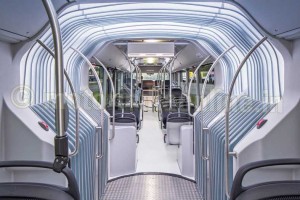 The wide range of bus chassis and complete buses from MAN forms an excellent basis for any BRT system. In several Chinese cities BRT routes are serviced by buses made under licence from MAN / NEOPLAN. In Dubai and Abu Dhabi, buses from MAN / NEOPLAN transport thou-sands of people to their destinations every day – a fast, smooth service in part on exclusive bus lanes.
The wide range of bus chassis and complete buses from MAN forms an excellent basis for any BRT system. In several Chinese cities BRT routes are serviced by buses made under licence from MAN / NEOPLAN. In Dubai and Abu Dhabi, buses from MAN / NEOPLAN transport thou-sands of people to their destinations every day – a fast, smooth service in part on exclusive bus lanes.
In Israel’s port city of Haifa, 84 futuristic BRT articulated buses based on 18.75-m MAN low-floor-type floor assemblies were successfully taken into regular service in August. At the end of this year, additional MAN BRT buses will provide state-of-the-art passenger transport on the so-called “Red Line” in Tel Aviv.
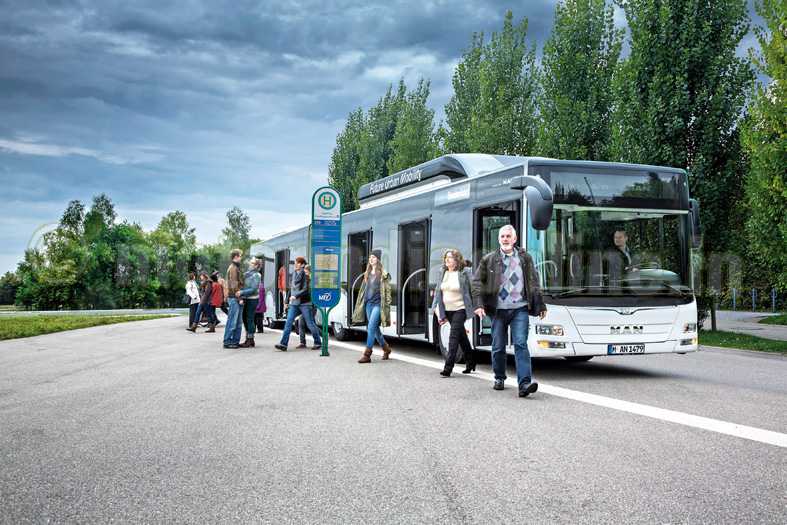 Busworld 2013 also saw MAN presenting a BRT version of the Lion’s City GL designed for inner-city routes with especially high passenger volumes. The 18.75-metre articulated bus has five doors in double the normal width – one door more than the standard articulated bus. This ensures that even with a high passenger volume, the flow of passengers is optimal and the stops are very short.
Busworld 2013 also saw MAN presenting a BRT version of the Lion’s City GL designed for inner-city routes with especially high passenger volumes. The 18.75-metre articulated bus has five doors in double the normal width – one door more than the standard articulated bus. This ensures that even with a high passenger volume, the flow of passengers is optimal and the stops are very short.
In addition, the interior seating architecture has been conceptualised for short distances and time-saving boarding and alighting. Passenger flow has been further optimised by equipping the vehicle with a total of nine ticket-validating machines which are also capable of scanning electronic tickets purchased by smartphone. Moreover, the BRT vehicle offers its passengers a free WiFi hotspot for Internet access.
Its interior is compelling, with top-quality materials and innovative lighting: four light strips with more than 1,500 LEDs (energy-saving light-emitting diodes) illuminate the compartment, giving it a friendly, evenly-lit look. Two extra bright, pure white LED strips in the center of the ceiling provide the vehicle’s basic illumination, while two more LED strips running the entire length of the bus are able to generate defined colours. They act as backlights to ceiling elements made of translucent polycarbonate, whose entire surfaces then take on the respective hue.
The LED lighting reduces the power drain of the BRT bus, meaning that less generator output is required. Headlights equipped with LED daytime driving lights and rear lights employing the same technology make additional contributions to energy saving.
Propulsion is provided by an MAN E2876 CNG engine in Euro 6, for operation with either natural or bio-gas. Four-speed automatic transmission, SensoTop control and integrated retarder ensure especially eco-friendly urban local public transport. With a volume of 2050 litres, the CNG tanks on the vehicle roof enable a long operating range.
Studies on efficient local public transport
In co-operation with the Berlin Weissensee Academy of Art, MAN Truck & Truck has worked out various design concepts as a creative contribution to the advanced development of the omnibus. The results of the “Future of the Omnibus” study can be seen in innovative draft designs of vehicles for local public transport that sensibly combine ideas for the greatest possible mobility with unconventional product design.
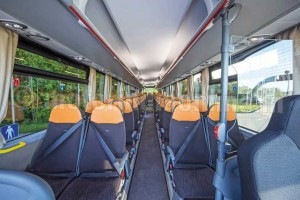 In joint discussions with bus experts from MAN, nine impressive concepts were worked out, ranging from KONVOI solutions for fleets of buses to a new driver workplace, from a draft interior design for variable, safe and fast passenger flows to compact, secure holders for bicycles and baby carriages in the passenger compartment. Intensive debate on this issue clearly showed just how much potential there is in the design of the bus as a transport mode.
In joint discussions with bus experts from MAN, nine impressive concepts were worked out, ranging from KONVOI solutions for fleets of buses to a new driver workplace, from a draft interior design for variable, safe and fast passenger flows to compact, secure holders for bicycles and baby carriages in the passenger compartment. Intensive debate on this issue clearly showed just how much potential there is in the design of the bus as a transport mode.
In “What Cities Want”, a study carried out for MAN by the Technical University of Munich, 15 metropolitan centers from around the world give accounts of how they want to develop at-tractive forms of urban mobility in the future. Using examples from different cities, the study demonstrates the opportunities that urbanisation offers. Even today, these cities are creating the prerequisites for efficient, accessible and ecologically sound mobility.
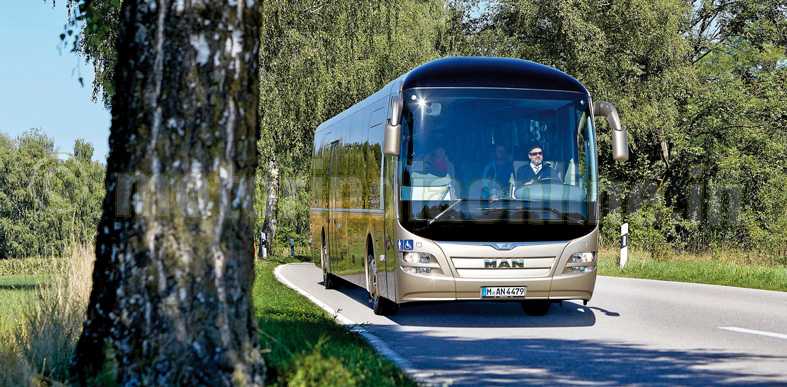 The top priority: expansion and improvement of all aspects of local public transport. This entails primarily more routes, higher frequencies and greater reliability of service. This is how major cities are reacting to the demands of their citizens: next to travelling time, the quality of what local public transport offers is decisive in their selection of transport mode.
The top priority: expansion and improvement of all aspects of local public transport. This entails primarily more routes, higher frequencies and greater reliability of service. This is how major cities are reacting to the demands of their citizens: next to travelling time, the quality of what local public transport offers is decisive in their selection of transport mode.
Integrated mobility plans, combined modes of transport, ambitious environmental objectives and right-of-way for alternative drives: the study puts across several innovative solutions and provides an overview of the varied strategies for sustainable urban mobility.